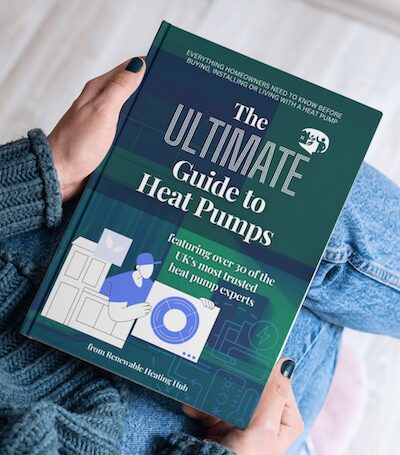Air Changes per Hour - ACH and the MCS requirement
It is expensive to gear up for either Pulse or Fan testing, some where between £10,000 and £20,000 for all the equipment and training but it would be a very thorough heat loss calculation if we removed more of the guessing or standard assumptions. I personally have an issue with cutting corners be it deliberate or permissible, I don't like guessing and I don't like rule of thumbs or approved assumptions, what i learned over the last 30 years is that buildings are often unique and are used uniquely, the better understanding you have of the building, its use and its condition the better you can serve it. (I don't doubt my lack of cutting corners is why I am not rich after 20+ years of doing this) 🙂
Thank for the input I will keep it in mind as part of our review on expansion of services we offer.
AAC Group Ltd covering the Kent Area for design, supply and installation of ASHP systems, service and maintenance, diagnostics and repairs.
Professional installer. Book a one-to-one consultation for pre- and post-installation advice, troubleshooting and system optimisation.
Posted by: @ashp-bobbaIt is expensive to gear up for either Pulse or Fan testing, some where between £10,000 and £20,000 for all the equipment and training
Wow, I never imagined the equipment would be that expensive. That presumably changes the economics somewhat!
4kW peak of solar PV since 2011; EV and a 1930s house which has been partially renovated to improve its efficiency. 7kW Vaillant heat pump.
@jamespa for the cheapest Its about £6500 +Vat, and £200 training, the more expensive is £11,000 and training and a loss of days works so If I get one set may 7k or 3 sets one for each team then 21k. We could start with 1 and then see how it goes.
AAC Group Ltd covering the Kent Area for design, supply and installation of ASHP systems, service and maintenance, diagnostics and repairs.
Professional installer. Book a one-to-one consultation for pre- and post-installation advice, troubleshooting and system optimisation.
Posted by: @ashp-bobba@jamespa for the cheapest Its about £6500 +Vat, and £200 training, the more expensive is £11,000 and training and a loss of days works so If I get one set may 7k or 3 sets one for each team then 21k. We could start with 1 and then see how it goes.
@ashp-bobba My personal perspective on this, based on my own experience and the sad stories I read on this forum, is that the industry as a whole (I'm emphatically not speaking about you - you obviously have it under control) needs (a) to admit that it has a problem with over-sizing and (b) get to grips with it. At present we mostly hear either excuses or denials (again not from you, but from some others - including it must be said MCS - I have their excuse on record!)
If, as you say, ACH is one of the biggest unknowns, then getting to grips with it involves either measuring ACH or determining (or at least sense checking) heat loss by a means other than the fabric spreadsheet (eg consumption data).
I can see that a large investment isn't attractive and that you (or anyone else making the investment) might never see a return, so I do sympathise. However I also sympathise with those customers who end up with an installation compromised by gross oversizing, of which there are a fair few on this forum.
Perhaps the industry as a whole just needs to bite the bullet, tool up to do the job properly (and, whilst its at it, stop ignoring fabric upgrades that surveyors cant see - which some do) and determine loss more robustly than is currently the case.
The only other way out of this, so far as I can see, is to wait until manufacturers develop heat pumps with a 6:1 modulation ratio (I pick this number because it allows for reasonable operation at low load in a heat pump oversized by a factor of 2 - which is what I was initially offered). Whether that likely and in what timescale I don't know - compressor technology is surely pretty mature so it might depend on solutions such as Mitsubishi's 2 compressor 8kW model, which will inevitably push up costs.
If you do decide to 'break the mould' then I very much wish you luck and hope it proves to be a wise investment.
4kW peak of solar PV since 2011; EV and a 1930s house which has been partially renovated to improve its efficiency. 7kW Vaillant heat pump.
@jamespa Its interesting that 10% miscalculation on design and can make such a big difference to running costs compared to the boiler days. I think we will look into air testing as a part of our development of the department in the near future.
AAC Group Ltd covering the Kent Area for design, supply and installation of ASHP systems, service and maintenance, diagnostics and repairs.
Professional installer. Book a one-to-one consultation for pre- and post-installation advice, troubleshooting and system optimisation.
@ashp-bobba Talking of over-sizing (and if you dont mind me asking) what do you suggest for a load such as 3-4kW. There is another thread where this is being discussed, and its noticeable that most manufacturers don't make anything less than about 5kW(or if they do it looks, based on dimensions and refrigerant charge, like a badge-engineered, software limited, version of their 5-8kW model). In fact the only one I have found (bearing in mind that Im not a professional) is this rather strange (but perhaps interesting) device.
That said, if my house loss were only 3kW, I wouldn't be that bothered about efficiency - and 5-6kW is probably about the minimum you want for reasonable DHW reheat time.
4kW peak of solar PV since 2011; EV and a 1930s house which has been partially renovated to improve its efficiency. 7kW Vaillant heat pump.
@jamespa Hi James, I never mind these questions as its helps me learn too. I see this a lot, so I think there is currently no market value for them to make a smaller unit than 5kW at the moment, 80% of homes at the moment will be 5 or more. In the future 30 years + enough modern houses will be built or old homes beefed right up with insulation and they will all be 2's and 3's for sure, until then using a 5kW running at 40% is likely the best option and I fully agree with you that its not the end of the world if you use a 5 cycling a bit costing you 20% more (so £80) of whats likely to be a £400 heating bill all year.
I cant think of any clever way to make a 3kW heat load use 5kW but not cost more or the same money as it using 3kW cycling a bit, perhaps build a conservatory and dump the heat in there or stick a rad in and heat the loft a bit, in my mind that still a bit of a waste of heat but would stop it cycling so the question would be, whats better, cycle the heat pump a bit or waste a bit of heat in the loft? (what would you do if these were your choices?)
AAC Group Ltd covering the Kent Area for design, supply and installation of ASHP systems, service and maintenance, diagnostics and repairs.
Professional installer. Book a one-to-one consultation for pre- and post-installation advice, troubleshooting and system optimisation.
Posted by: @ashp-bobbacant think of any clever way to make a 3kW heat load use 5kW but not cost more or the same money as it using 3kW cycling a bit, perhaps build a conservatory and dump the heat in there or stick a rad in and heat the loft a bit, in my mind that still a bit of a waste of heat but would stop it cycling so the question would be, whats better, cycle the heat pump a bit or waste a bit of heat in the loft? (what would you do if these were your choices
It's a good question.
With a house that has sufficient heat capacity (eg one with ufh in a slab) batch heating at cheap rate is probably a good approach. It sacrifices efficiency but with cheap rate electricity cost overcomes this.
With a house that cools more quickly, perhaps a bit of this with top ups.
Otherwise just let it cycle would probably be my choice.
Certainly a case for experimenting.
4kW peak of solar PV since 2011; EV and a 1930s house which has been partially renovated to improve its efficiency. 7kW Vaillant heat pump.
@jamespa I have not had a heat calc yet that is below 4.9kW so, so far so good for me but I am sure at some point I will do one. will also soon fit a 6kW ASHP to my new house which has 10mm copper tails in the wall, as an experiment I am just going to stuff the HP on the end of the 28/22 mm circuit without any mods and see how it pans out, measure all of the flows, DT and noise and record what i do to overcome the issues.
I am doing this like an R&D job so I can better understand the challenges, I also think I will probably end up with a different heat pump every year just to test them all out. I might try and deliberately oversize it and compare it to the correct sizing.
I am also looking to purchase a new warehouse which I will probably fit an ASHP with one of everything, fan coil, rad, UFH and sunamp as well as a cylinder, solar and any kind of controllers (3RD PARTY) I can lay my hands on for free so when these fancy blue tooth TRV's or centralising super smart stats come out I can test them and recommend them with confidence. I have a bit of a 5 year plan you could say.
AAC Group Ltd covering the Kent Area for design, supply and installation of ASHP systems, service and maintenance, diagnostics and repairs.
Professional installer. Book a one-to-one consultation for pre- and post-installation advice, troubleshooting and system optimisation.
Sounds very interesting. It seems to me that this is an exciting time to be in the renewable heating market as there is going to be lots of innovation and evolution of understanding over the next 20 years.
Equally interesting would be power engineering and energy tariffing, the games to be played with those are potentially fascinating and as batteries become more widespread and we start to use the two ton lumps parked on our driveways as an energy arbitrage enabler, all sorts of things become possible.
I was lucky enough to spend my early career in fibre optics, when the technology was at the peak of its development in the 80s/90s. Being even near the front line was definitely a privilege. It's possible that a bit of nostalgia for this period is driving my current interest in this forum!
4kW peak of solar PV since 2011; EV and a 1930s house which has been partially renovated to improve its efficiency. 7kW Vaillant heat pump.
@jamespa I love going on the tools, I did it yesterday, the engineers just look at me and smile like I should get back in the van lol.
Last year I worked with our HP engineer for 6 months solid, office, design and installation for her final training and qualifying as I am our certified NVQ assessor and once it was over I was a bit sad as I got right back in to being on site. The nice bit was my senior office manager said " thank the lord your back" so I guess i am ok at the office stuff sometimes too.
If ever your in Kent ping me a message and I will show you the setup 🙂
AAC Group Ltd covering the Kent Area for design, supply and installation of ASHP systems, service and maintenance, diagnostics and repairs.
Professional installer. Book a one-to-one consultation for pre- and post-installation advice, troubleshooting and system optimisation.
Posted by: @matwinobviously those draughts need to be dealt with but the heat loss now looks like 7.5kW which is perfect for a Vaillant 7kW heat pump which can do over 8.4kW when necessary.
There have been a few discussions dotted around (e.g. I think Urban Plumber had a video on YouTube) where the 8.4 kW is not accounting for defrosts, meaning that in our climatic conditions it will often not be able to hit this as an average output across the day. (Although when we get to design temperature there should be less moisture in the air).
IMHO if going down this route I would want to be confident that there was ample system volume to reduce the work needed to recover from defrost cycles (don't want a death loop). I would also weigh up the cost of the optional backup heater / might even go as far as ensuring the immersion can be intelligently controlled (e.g. if you wanted to use that rather than the heat pump on days it might struggle to enable it to focus on heating). I'd also want to be targeting a reasonably low flow temperature (again to reduce work) - but have seen mentions that on UFH only installations (more generally) you can end up with not enough energy in the system volume to complete a defrost if your flow temperature is too low (minefield or what!?)
I'm not saying don't do it, just do it with your eyes open. We've got the 12kW version and the double fan unit is large. Based on this winter's performance our heat loss (with 19C target) appears to be 7kw (but I've yet to fully sort out some loft insulation). This matches my original estimates.
If I had been super confident in my initial estimates then I would have pushed for the smaller heat pump as I feel the larger unit has a ceiling of efficiency in the milder weather (when it barely needs to run) and I'd personally be ok with a small risk of dipping just below target temperature for the coldest hours of the year. However, I probably would include a volumiser and would want better control on the immersion (currently just on / off switch). I would have also costed up the optional backup heater, but hopefully it would be only needed for limited running hours (if at all) so might not make financial sense.
One advantage I do see on the oversized unit is a quicker DHW reheat time so less time with the house not being heated.
- 26 Forums
- 2,357 Topics
- 53.5 K Posts
- 266 Online
- 6,025 Members
Join Us!
Worth Watching
Latest Posts
-
RE: Midea ASHP – how to set weather compensation
@pash44pump I have yet to come across any Clivet or Mid...
By benson , 25 minutes ago
-
RE: Who's your electricity provider and what's your tariff?
@transparent Thanks, this helps. Could it be that St...
By Batpred , 50 minutes ago
-
My Powerwall 3 Consumes 3-4 kWh/Day in Self-Consumption: Is This Normal?
I had solar panels & Powerwall 3 installed in Augus...
By Caron , 2 hours ago
-
-
RE: Clivet ASHPs and weather compensation
@simon-w Did this get resolved because my installer is ...
By pash44pump , 3 hours ago
-
MyVaillant Connect Regular Disconnect
A couple of weeks ago the MyVaillant Controller had a r...
By buckwem , 13 hours ago
-

RE: Setback savings - fact or fiction?
I could, but I think we can do better, by plotting hour...
By cathodeRay , 18 hours ago
-
RE: Advice on internal circulation pump noise
Extend the primary branch and make sure you have more t...
By ASHP-BOBBA , 21 hours ago
-

RE: External pipework insulation
Oh Dear! that's appalling pipe work, should've been in ...
By dgclimatecontrol , 1 day ago
-

RE: Jokes and fun posts about heat pumps and renewables
By Morgan , 1 day ago
-

RE: Controlling Daikin Altherma via P1P2 and Home Assistant
On the contrary, @toodles, that’s a lot of help. I’d ne...
By Majordennisbloodnok , 1 day ago
-
RE: Octopus Cosy Heat Pump Owners & Discussion Thread
@kevh with the Cosy 6 I know it definitely goes to arou...
By HarrisonC , 2 days ago
-

Parsnip, Bacon & Coconut Milk Soup
First let me say, I am only a cook because I am human a...
By Toodles , 2 days ago
-
RE: Electricity price predictions
Ben Watts posted on LinkedIn that he had updated this w...
By Judith , 2 days ago
-

RE: The good, the bad and the not that great – my heat pump installation
Small update, Emailed and Spoke to Midea UK and they ...
By Burtis , 2 days ago
-
RE: Solis S6-EH1P8K-L-PLUS – Why I Chose It and What I’ve Learned So Far
@bash Octopus does charge for the admin. The process al...
By Batpred , 2 days ago
-
RE: New Fogstar 15.5kWh upright solution
Issues still under investigation by Solis... Fogstar ...
By Batpred , 2 days ago
-

RE: Heat Pump Heats the House… But It’s Not Cosy. Emitter Changes or System Tweak?
@toodles interesting suggestion, thanks. I will try to...
By GrahamF , 3 days ago





